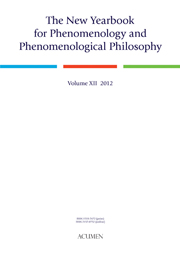Book contents
- Frontmatter
- Contents
- Articles
- Three Levels of Historical Analysis in Early Heidegger
- Heidegger's Schematism of Life and its Kantian Inheritance: A Critical Appraisal
- Husserl's Mereological Semiotics: Indications, Expressions, Surrogates
- Process and Relation: Husserl's Theory of Individuation Revisited
- Mathesis Universalis and the Life-World: Finitude and Responsibility
- Multiplicity, Manifolds and Varieties of Constitution: A Manifesto
- Phenomenology in the United States
- Documents
- In Review
Heidegger's Schematism of Life and its Kantian Inheritance: A Critical Appraisal
from Articles
- Frontmatter
- Contents
- Articles
- Three Levels of Historical Analysis in Early Heidegger
- Heidegger's Schematism of Life and its Kantian Inheritance: A Critical Appraisal
- Husserl's Mereological Semiotics: Indications, Expressions, Surrogates
- Process and Relation: Husserl's Theory of Individuation Revisited
- Mathesis Universalis and the Life-World: Finitude and Responsibility
- Multiplicity, Manifolds and Varieties of Constitution: A Manifesto
- Phenomenology in the United States
- Documents
- In Review
Summary
“Time must be understood as pure self-affection; otherwise its function in the formation of schemata remains completely obscure”
— Kant and the Problem of MetaphysicsAbstract: As a philosophical problem, schematism has been well known as a Kantian issue. This paper suggests that Heidegger inherited Kantian schematism and has resolved to overhaul it to adapt it to his own doctrine. By reviewing the notion of time since Newton, by showing the terminological and philosophical kinship between Heidegger with Kant, and by reproducing a chart conceived some thirty years ago by Otto Pöggeler, this paper further argues that, unlike the Kantian schematism, which explains how categories are applicable to empirical nature, Heidegger expounded in his magnum opus Sein und Zeit an implicit “schematism of life,” which accounts for how Dasein as original time unfolds itself through 3 × 2 = 6 ecstatical modi to constitute the life world of individual human Dasein. It is from this new angle that a host of conceptual and interpretative issues are raised for critical reflection and reappraisal.
Keywords: Heidegger, Kant, schematism, time, temporality, philosophy of life
Schematism as a Philosophical Problem
As a philosophical problem, schematism has been widely known as a Kantian issue. This paper will try to show that schematism, which was deeply rooted in the Western tradition before Kant, was taken up and further developed by Heidegger, despite his apparent reservation for and criticism of Kant's thematic treatment of the issue.
- Type
- Chapter
- Information
- Publisher: Acumen PublishingPrint publication year: 2013



